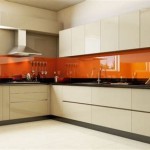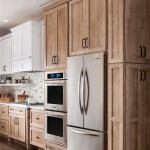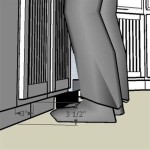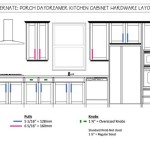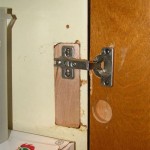How To Deep Clean Greasy Kitchen Cabinets
Kitchen cabinets, particularly those near the stove, are often magnets for grease, grime, and cooking splatters. Over time, this buildup can become sticky, unsightly, and difficult to remove with regular cleaning methods. A deep cleaning process is necessary to restore the cabinets to their original condition and prevent long-term damage. This article provides a comprehensive guide on how to effectively deep clean greasy kitchen cabinets, covering the necessary supplies, preparation steps, and detailed cleaning techniques.
Key Point 1: Gathering Supplies and Preparing the Kitchen
Before starting the deep cleaning process, it is crucial to gather the necessary cleaning supplies and prepare the kitchen area. This preparation ensures a smooth and efficient cleaning experience.
Essential Cleaning Supplies:
A variety of cleaning agents can be effective in removing grease and grime. The choice of cleaner often depends on the cabinet material and the severity of the buildup. Here are some commonly used options:
- Dish Soap: Mild dish soap is a good starting point for general cleaning and can be effective on light grease buildup.
- Baking Soda: Baking soda is a natural abrasive that can help scrub away stubborn grease stains. It is also gentle enough for most cabinet finishes.
- Vinegar: Vinegar is an excellent degreaser and can help break down grease and grime. Diluted white vinegar is generally safe for most surfaces, but it is essential to test it in an inconspicuous area first.
- Commercial Degreasers: Numerous commercial degreasers are available specifically formulated for kitchen surfaces. These products are often more powerful than homemade solutions, but they may also contain harsh chemicals. Always follow the manufacturer's instructions and wear appropriate protective gear when using commercial degreasers.
- Orange Oil/Citrus Cleaners: Orange oil and citrus-based cleaners are effective degreasers that also leave a pleasant scent. They are a natural alternative to harsher chemicals.
- Rubbing Alcohol: Rubbing alcohol can be used to remove sticky residue and stains. It is particularly effective on glossy surfaces.
- Magic Eraser Sponges: Magic Eraser sponges are abrasive cleaning tools that can remove stubborn stains and grime. However, they can also scratch some surfaces, so it is important to test them in an inconspicuous area first.
In addition to cleaning agents, the following supplies are also necessary:
- Spray Bottles: For applying cleaning solutions.
- Microfiber Cloths: For wiping surfaces clean. Microfiber cloths are absorbent and gentle on cabinet finishes.
- Sponges: For scrubbing stubborn stains. Use non-abrasive sponges to avoid scratching the cabinets.
- Soft-bristled Brush: For cleaning crevices and textured surfaces. An old toothbrush can be useful for reaching tight spots.
- Scrub Brush: For heavily soiled areas, but use with caution to avoid scratching.
- Warm Water: For rinsing surfaces clean.
- Bucket: For holding warm water.
- Rubber Gloves: To protect hands from harsh chemicals and hot water.
- Eye Protection: To protect eyes from splashes.
- Step Stool or Ladder: For reaching high cabinets.
- Drop Cloth or Old Towels: To protect countertops and floors from drips and spills.
- Screwdriver: For removing hardware (knobs, handles) if desired.
Kitchen Preparation:
Preparing the kitchen area is essential to protect surrounding surfaces and ensure a safe and efficient cleaning process.
- Clear the Countertops: Remove all items from the countertops beneath the cabinets. This will provide ample space for cleaning and prevent items from getting damaged.
- Protect the Countertops and Floors: Cover the countertops and floors with drop cloths or old towels to protect them from drips and spills.
- Ventilate the Kitchen: Open windows and doors to provide adequate ventilation, especially when using commercial degreasers or other cleaning agents with strong odors.
- Remove Hardware (Optional): Remove knobs, handles, and other hardware from the cabinets. This will allow for easier cleaning and prevent the hardware from getting damaged. Store the hardware in a safe place so it is not lost.
Key Point 2: Deep Cleaning Techniques for Greasy Cabinets
Once the supplies are gathered and the kitchen is prepared, the deep cleaning process can begin. The following techniques outline how to effectively remove grease and grime from kitchen cabinets.
Step-by-Step Cleaning Process:
- Dust and Wipe Down: Begin by dusting the cabinets with a dry microfiber cloth to remove loose dirt and debris. This will prevent the dirt from becoming embedded in the grease during the cleaning process.
- Apply Cleaning Solution: Choose a cleaning solution based on the level of grease buildup and the cabinet material. For light grease buildup, a solution of warm water and dish soap may be sufficient. For heavier grease buildup, a mixture of baking soda and water or diluted white vinegar may be necessary. Spray the cleaning solution onto a microfiber cloth or sponge and apply it to the cabinet surfaces. Avoid spraying the solution directly onto the cabinets, as this can damage the finish.
- Allow Solution to Sit: Allow the cleaning solution to sit on the cabinet surfaces for several minutes to soften the grease and grime. The amount of time will depend on the severity of the buildup. For stubborn grease, allow the solution to sit for up to 10-15 minutes.
- Scrub the Cabinets: Use a non-abrasive sponge or soft-bristled brush to scrub the cabinets. Focus on areas with heavy grease buildup, such as around the stove and handles. For stubborn stains, use a baking soda paste or a Magic Eraser, but be careful not to scratch the surface. Use a scrub brush for areas that need a heavy cleaning touch.
- Rinse with Clean Water: After scrubbing, rinse the cabinets with clean, warm water. Use a clean microfiber cloth or sponge to remove any remaining cleaning solution and grease. Be sure to wring out the cloth or sponge frequently to avoid spreading the grease around.
- Dry the Cabinets: Dry the cabinets thoroughly with a clean, dry microfiber cloth. This will prevent water spots and streaks from forming.
- Clean Hardware: If the hardware was removed, clean it separately using the same cleaning solution used for the cabinets. Rinse and dry the hardware thoroughly before reattaching it to the cabinets.
Specific Cleaning Challenges:
Certain areas and types of grease buildup may require special attention.
- Around Handles and Knobs: This area often accumulates the most grease and grime. Use a soft-bristled brush or an old toothbrush to scrub around the hardware and remove embedded dirt.
- Around the Stove: Cabinets near the stove are prone to heavy grease buildup. Use a stronger cleaning solution, such as a commercial degreaser or a baking soda paste, to effectively remove the grease.
- Inside Cabinets: Clean the inside of the cabinets with warm, soapy water. Remove any spills or stains and dry thoroughly.
- Textured Cabinets: Textured cabinets can be difficult to clean because grease and grime can become trapped in the crevices. Use a soft-bristled brush to reach into the crevices and remove the buildup.
Additional Tips:
- Test Cleaning Solutions: Always test any cleaning solution in an inconspicuous area before applying it to the entire cabinet. This will ensure that the solution does not damage the finish.
- Avoid Abrasive Cleaners: Avoid using abrasive cleaners or scouring pads, as these can scratch the cabinet finish.
- Work in Sections: Clean the cabinets in sections to prevent the cleaning solution from drying out and becoming difficult to remove.
- Rinse Thoroughly: Rinse the cabinets thoroughly to remove all traces of the cleaning solution. Residue can attract dirt and grime.
- Dry Immediately: Dry the cabinets immediately after rinsing to prevent water spots and streaks from forming.
Key Point 3: Maintaining Clean Cabinets and Preventing Grease Buildup
After deep cleaning the kitchen cabinets, it is important to establish a regular cleaning routine to prevent grease buildup and maintain their cleanliness. Regular maintenance will significantly reduce the need for frequent deep cleaning.
Regular Cleaning Routine:
- Wipe Down Regularly: Wipe down the cabinets with a damp microfiber cloth at least once a week to remove surface dirt and grime. This will prevent the buildup from becoming ingrained.
- Clean Spills Immediately: Clean up spills immediately to prevent them from staining the cabinets. Use a damp cloth to wipe up the spill and dry the surface thoroughly.
- Ventilate the Kitchen: Use the range hood or open windows when cooking to help remove grease and steam from the air. This will reduce the amount of grease that settles on the cabinets.
- Use a Backsplash: Install a backsplash behind the stove to protect the cabinets from splatters. A backsplash is much easier to clean than the cabinets themselves.
- Consider Cabinet Liners: Use cabinet liners to protect the inside of the cabinets from spills and stains. Cabinet liners are easy to remove and clean.
Preventative Measures:
In addition to regular cleaning, several preventative measures can help minimize grease buildup on kitchen cabinets.
- Use a Grease Splatter Screen: Use a grease splatter screen when frying or cooking with oil to prevent splatters from reaching the cabinets.
- Clean the Range Hood Filter: Clean the range hood filter regularly to remove trapped grease. A clogged filter will reduce the range hood's effectiveness and allow more grease to settle on the cabinets.
- Avoid Overfilling Pots and Pans: Avoid overfilling pots and pans when cooking to prevent splatters.
- Use Covered Containers: Use covered containers when storing food in the cabinets to prevent spills and leaks.
- Apply a Protective Coating: Consider applying a protective coating to the cabinets, such as a wax or sealant. This will help to repel grease and make the cabinets easier to clean. Note: Ensure the chosen product is compatible with the cabinet finish.
By following these cleaning techniques and implementing preventative measures, it is possible to maintain clean, grease-free kitchen cabinets and extend their lifespan. Consistent maintenance is key to preventing the accumulation of stubborn grease and grime, resulting in a cleaner and more aesthetically pleasing kitchen.

How To Clean Kitchen Cabinets Everyday Skate

Get Grease Off Kitchen Cabinets Easy And Naturally

How To Clean Sticky Grease Off Kitchen Cabinets Ovenclean

Degrease Kitchen Cabinets With An All Natural Homemade Cleaner

How To Remove Thick Grease From Kitchen Cabinets When Everything Else Fails

How To Clean Grimy Kitchen Cabinets With 2 Ingredients

How To Deep Clean Kitchen Cabinets And Keep Them Looking Gorgeous Everyday Skate

5 Tips On How To Clean Grease Off Kitchen Cabinets Tlc Cleaning

How To Clean Painted Kitchen Cabinets By Kayla Payne

How To Remove Thick Grease From Kitchen Cabinets When Everything Else Fails
Related Posts

